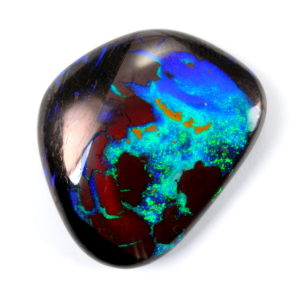We get Jeweller Magazine – a trade magazine published by the Jeweller’s Association of Australia, delivered to us once a month. There’s always interesting articles about what’s going on the world of jewellery and gems, plus it helps us to follow trends. However, this particular issue (March 2011) had a very interesting article written by Ian ‘Mac’ McArthur (retailer,opal lover, Opals4Sale.com). It was so interesting that we decided to blog it for you to form your own opinions over.
Opal has the power to eclipse jewellery lovers, says Ian McArthur – of only retailers would give Australia’s national gem the treatment it deserves.
‘I didn’t think that I liked opal, but , wow, these are amazing!’ I regularly hear this type of comment. Why is it that the Australia public think they don’t like opal? Is it because retailers off too little and charge too much, choosing to stock opals that have very little colour, or classy looking triplets in unimaginative settings?
For too long the jeweller trade has left our national gemstone in the hands of specialty opal shops, where duty free signs and exorbitant prices have kept the Aussie public ignorant of its wonders.
Good opal at a fair price sells itself. Hand a $2,000 sapphire and $5,000 ruby to a customer, and then present them with an opal of equivalent value and see what happens. I guarantee they can spend far more time looking at the opal than the other two gems. And looking time is really important; if you can spend five or 10 minutes looking at a stone, you’re getting real value out of it.
I bet most jewellers don’t even know what gives opal its colourful characteristics. The colour in opal is created from light diffraction between spherical molecules that form the stone. So you could say that opal is the light of our great south land. And ain’t that something to shout about?
The light has certainly eclipsed overseas buyers. There exists a small area in southwest Queensland that has recently become extremely popular with Europeans and Americans. Why? Because it produces ironstone matrix opal. These exquisite stones are creating quite a storm around the world, but get little mention in our mainstream jewellery trade and I see little, if any, of this material displayed here in Australia.
Maybe this is because jewellers don’t think there’s a demand for it in Australia? Or maybe it’s because the trade, like the public, don’t understand the product? And if the trade doesn’t understand this gem, how can the public ever be expected to?
Perhaps our national gem hasn’t had the marketing it deserves. Who was it that said opals were an unlucky stone? De Beers, that’s who. After the second world war it launched a marketing campaign in Australia so powerful that it still resonates around the world today: opals are unlucky, they said, and every man should buy his fiance a diamond that costs one month’s salary.
So how can we reverse this national travesty? For a start, the jewellery industry could make more noise about opal. Do this beautiful gemstone the justice it deserves by promoting it, both in advertising and in shop displays. Posters of really interesting pieces can make a mesmerising store centrepiece.
Education is also key. Most store staff don’t even know that opal colour is diffracted light. How can they be expected to sell it if they don’t understand it? Teach staff what you want them to show off and point to, and these stones will fly out of your shop.
In today’s market, it’s likely that the pride opal has been a sticking point in Australia. But it is the world market of supply and demand that sets the price. The Swiss demand for cull colour centre nuts drives the price well beyond what we dinkum Aussies like to pay, but if we want them, we must cough up.
Compared with opal from Lightning Ridge and Coober Pedy, Queensland Yowah nuts and ironstone matrix are still relatively inexpensive. A very pretty stone can sell for as low as $20 or as high as $20,000, whereas the Ridge stones start at $20,000. Southwest Queensland opal does not cost a lot to stock, either. A decent display of loose stones is inexpensive relative to finished jewellery products.
Stocking loose stones gives your customers the chance to pick their own opal and then work with you to create a unique piece of jewellery, building a stronger bond with your customer. The shape, colour, and size of the stone will also help stimulate jewellery design ideas; it looks good in gold or silver, and coloured diamonds make great accent stones, from cognacs and yellows to greens.
Now here is some really good news that applies to southwest Queensland opal, and to no other product in the jewellery trade: ironstone matrix opal is so unique that the price for each piece is a one and only price: it can be priced according to desire. No one can say that it isn’t a ‘fair price’, or ‘that’s too much’. The pieces that I like I price high and the stones that I’m not so keen on get sold for less. They all sell; it’s just a matter of time. This then gives the retailer total price control.
Now ain’t that a bonus!


